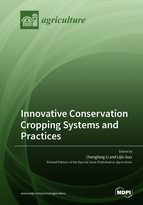Innovative Conservation Cropping Systems and Practices
A special issue of Agriculture (ISSN 2077-0472). This special issue belongs to the section "Crop Production".
Deadline for manuscript submissions: closed (30 September 2022) | Viewed by 41621
Special Issue Editors
Interests: conservation tillage; plant fertilization; water-saving irrigation; global warming potential; soil nutrient cycles; soil carbon sequestration; crop yield; soil microbial community; greenhouse gas emission
Interests: conservation tillage; soil organic carbon; carbon sequestration; soil microbial community; mycorrhizal fungi; abiotic stress; greenhouse gas emission; climate change impact and adaptation
Special Issue Information
Dear Colleagues,
Maintaining economically and environmentally sustainable cropping systems and practices is one of the most imperative challenges in innovative sustainable agriculture. In this view, it is essential to note that the sacrifice of crop yields in the farmland ecosystem may not appeal to farmers heavily focused on increasing economic outcomes. Therefore, a deeper understanding of how to innovate cropping systems and practices with the aim of maintaining sustainability in agriculture is of crucial importance. Innovative conservation cropping systems and practices can improve agroecosystems productivity, reduce energy input, increase synergies between food production and ecosystem conservation, and increase farmers’ profits.
This Special Issue focuses on the development and assessment of innovative conservation cropping systems and practices in determining system productivity and enhancing crop production and soil quality. This issue “Innovative Conservation Cropping Systems and Practices” will cover applied engineering for achieving a sustainable balance among productivity, environmental, and profitability factors. The aim is to present a collection of research articles that cover a broad range of cropping systems and practices from farmland ecosystem. All types of articles, e.g., original research, opinions, and reviews, are welcome.
Prof. Dr. Chengfang Li
Dr. Lijin Guo
Guest Editors
Manuscript Submission Information
Manuscripts should be submitted online at www.mdpi.com by registering and logging in to this website. Once you are registered, click here to go to the submission form. Manuscripts can be submitted until the deadline. All submissions that pass pre-check are peer-reviewed. Accepted papers will be published continuously in the journal (as soon as accepted) and will be listed together on the special issue website. Research articles, review articles as well as short communications are invited. For planned papers, a title and short abstract (about 100 words) can be sent to the Editorial Office for announcement on this website.
Submitted manuscripts should not have been published previously, nor be under consideration for publication elsewhere (except conference proceedings papers). All manuscripts are thoroughly refereed through a single-blind peer-review process. A guide for authors and other relevant information for submission of manuscripts is available on the Instructions for Authors page. Agriculture is an international peer-reviewed open access monthly journal published by MDPI.
Please visit the Instructions for Authors page before submitting a manuscript. The Article Processing Charge (APC) for publication in this open access journal is 2600 CHF (Swiss Francs). Submitted papers should be well formatted and use good English. Authors may use MDPI's English editing service prior to publication or during author revisions.
Keywords
- conservation tillage
- soil aggregate
- soil organic carbon
- soil nutrition
- crop yield
- soil microbial diversity
- conservation crop system
- greenhouse gas emission
- resource utilization efficiency
- tillage technology
- economic benefit






